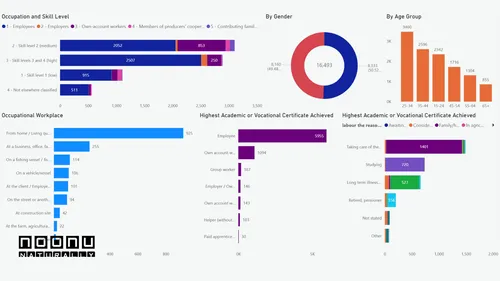Formal Education Attendance
Noonu Atoll exhibits a strong inclination towards formal education, with a significant majority of the population having attended school or an educational institution. Specifically, out of the total population, 95.87% have participated in formal education, while only 4.13% have never attended. This high attendance rate indicates a robust emphasis on education within the atoll. The data is consistent across different breakdowns, reinforcing the conclusion that formal education is a widespread experience in Noonu Atoll.
Educational Attainment Levels
The educational attainment levels in Noonu Atoll vary, with a range of academic and vocational qualifications represented. The most prevalent level of educational attainment is secondary education, with 5,062 individuals having achieved this level. This suggests that a substantial portion of the population has completed a significant phase of their education. Following secondary education, primary education is the next most common level, with 2,641 individuals holding this as their highest qualification. Additionally, there are individuals who have attained certificate/diploma level qualifications (1,755 individuals), higher secondary education (1,281 individuals), and degrees or higher (987 individuals). It is important to note that 464 individuals have never attended any educational institution, and 53 individuals' education level was not stated.
Literacy Levels
Literacy is a fundamental aspect of education, and the report provides insights into literacy levels in Noonu Atoll, focusing on both the dhivehi language and the English language.
Dhivehi Language Literacy: The literacy rate in the native language is notably high, with 98.23% being literate. This demonstrates that the vast majority of the population can read and write in their native language, which is crucial for cultural preservation and daily communication.
English Language Literacy: While native language literacy is widespread, literacy in the English language is less prevalent. Based on the report, 20.11% (2,786 individuals) are not literate in English. This indicates a disparity in second language proficiency, which could have implications for global communication, employment opportunities, and access to information in the English language. A significant majority, 79.89% (11,068 individuals) are literate in English.
Demographic Breakdown of Education
The report also provides a demographic breakdown of education in Noonu Atoll, looking at gender and age group.
Gender: The educational data is categorized by gender, showing attendance in formal education, highest academic or vocational certificate achieved, and literacy in English for both males and females. This breakdown allows for an analysis of educational equity and gender-based trends in educational attainment and literacy.
Age Group: Education data is also presented by age group, including attendance in formal education and literacy in English. The age groups are 15-24, 25-34, 35-44, 45-54, 55-64, and 65+. Analyzing education across these age groups provides insights into how educational access and outcomes have evolved over time, as well as the current educational profile of different generations. For instance, the 25-34 age group has 3,460 individuals, the highest among the age groups.
Active Education Levels
In addition to overall educational attainment, the report includes a breakdown of active education levels, showing the number of individuals currently enrolled at various stages of education. These levels range from early childhood education (Baby Nursery, Nursery, LKG/JKG, UKG/SKG) through primary and secondary education (Grades 1-12, Foundation, O’ level Class, A’ level Class, Special Need Class) to tertiary and higher education (Certificate, Diploma, First Degree...Masters Degree, PHD). This detailed categorization provides a snapshot of the current educational activities within Noonu Atoll, from the foundational levels to advanced academic pursuits.
In summary, the educational profile of Noonu Atoll, as depicted in the 2022 census report, reveals a population with a high level of engagement in formal education, a range of educational attainment levels, and varying degrees of literacy in native and English languages. The data also highlights demographic variations in education, providing a comprehensive view of the educational landscape in the atoll.
Other Libraries

Demographic Profile of Noonu Atoll
Noonu Atoll's 2022 census reveals a registered population of 16,493 and a residential population of 16,637, with gender disparities noted (more females residing). The data includes breakdowns by island, marital status, age, and residential origin.
Noonu Atoll Council
reports

Labour Force
This interactive dashboard provides a detailed visualization of labour force statistics across Noonu Atoll, transforming raw data into meaningful insights for decision-makers, stakeholders, and the community.
Noonu Atoll Council
reports